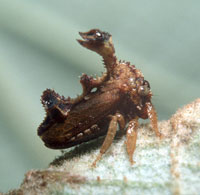We have moved to a new server!
Since March 2014, this website has been moved to this new server: http://web.ntnu.edu.tw/~treehopper/. This page will not be updated anymore. Please update your browser’s bookmark or the web links.
Member list
Current members
- Jo-Fan Wang
- 1. The Territorial Behavior of Euphaea formosa (Odonata). 2. Tempo and Mode of Pronotal Evolution in Membracis Treehoppers.
- Hung-Nien Chen
- 1. The effect of typhoon on survivalship of Matrona cyanoptera. 2. Modes of phenotypic variation in Euphaea amphicyana.
- Lan-Wai Yeh
- Ecology and evolution of Taiwanese Carabus ground beetles.
- Yun-Chieh Cheng
- What do damselfly larvae eat? DNA barcode analyses of larval diet in Matrona cyanoptera and Euphaea formosa.
- Chung-Hsin Huang
- Flucuating Asymmetry and Developmental Asymmetry of Cyclommatus mniszechi.
- Hui-Yun Tseng
- 1. Biological function of coloration in Pachyrrhynchus tobafolius. 2. Phylogeny and color evolution of Pachyrrhynchus weevils. 3. Population genetics of Pachyrrhynchus weevils on Lanyu and Green Island.
- I-Ting Hsiao
- Variation of genitalia in Euphaea amphicyana.
- Yen-Ting Chen
- The effect of forest management of Mt. Da-Shiue on the morphological variation of a ground beetle, Carabus (Apotomopterus) masuzoi.
- Jyun-Huei Huang
- The fighting behavior of a stag beetle, Rhaetulus crenatus.
- Shi-Ting Wu
- Membracis Phyllotropis.
- Chiao-Wei Lin
- The fighting behavior of a stag beetle, Rhaetulus crenatus.
- Yong-Chao Su
- Behavioral ecology, sociobiology, population genetics, and molecular phylogenetics.
Past members
- Wei-Liang Xiao
- Variation of wing veins in Euphaea amphicyana.
- Li-Wen Weng
- Why do firefly larvae emit light?
- Yat-Hung Lee
- Speciation of Euphaea damselflies.
- Che-Yu Kuan
- Variation of mandibles in stag beetles.
- Chu-Yen Cheng
- Phylogeography of a Philippine's treehopper, Leptocentrus reponens.
- Ming-Yu Chen
- Shao-Chang Huang
- Visual Communication of Matrona cyanoptera
- Jen-Pan Huang
- Population Genetics and Phylogeographic Analyses of Formosan Damselfly, Euphaea Formosa (Insecta: Odonata: Euphaeidae) from Taiwan
- Wei-Yun Chen
- Molecular and Phylogenetic Characterization of Endosymbiotic Bacteria of the Froghopper, Okiscarta uchidae (Insecta: Hemiptera: Cercopidae)
Visiting scholars and students
- Vanitha Williams
- Predatory potential of waterbug, Diplonychus rusticus and dragonfly, Diplacodes trivialis on mosquito larvae.
- Marina Vilenica
- Dragonfly composition (Insecta, Odonata) in wetland area of Turopolje region, Croatia
- Klaas-Douwe 'KD' B. Dijkstra
- History, diversity and identification of dragonflies and damselflies (Odonata).
- Erin McCullough
- " Diversification of weapon form: aerodynamic costs of beetle horns.
- Ashley E. King
- Intrasexual combat and intersexual antagonistic co-evolution in horned beetles.
Ming-Yu Chen

Title
Master Student & Research Assistant 2005-2010
Species: Membracidae: Centrochares horifficus

Project
Phylogeography and population history of the treehoppers, Centrochares horifficus from the Philippines Archipelago.
Abstrct
E-mail:mingyu_0202@yahoo.com.tw
Oceanic islands provide ideal natural laboratories for studying processes of lineage diversification. With more than seven thousand islands, the Philippine archipelago is an area of high endemism and one of the biodiversity hot spots in the world. We investigated how past geological/geographic events and biological features shaped the phylogeographic patterns and genetic structures of a widespread treehopper, Centrochares horrificus (Insecta: Hemiptera: Membracidae) of the Philippine archipelago. Phylogenetic analyses of mitochondrial and nuclear genes for ten island populations suggested that Palawan lineage was ancestral to the oceanic Philippine islands. Reconstructed phylogenies were broadly consistent with proposed island relationships based on a strict vicariance hypothesis, and showed that the lineage’s age was related to island’s ages in which the older islands were inhabited by more ancient lineages. Analyses of molecular data revealed significant genetic differentiation within islands, among islands within PAICs, and among PAICs. Genetic diversities were found to show significantly positive correlation with sizes of current islands and PAICs. Network analyses and gene flow estimation indicated that the ancestral populations of the C. horrificus in the oceanic Philippine island have originated in Mindanao, followed by a largely northward expansion into surrounding islands. Historical gene flow was highly asymmetric between islands and occurred most frequently in central Philippines (Visaya), with larger islands of central-southern Luzon and Mindanao functioned as source populations.
Present address:
Australia